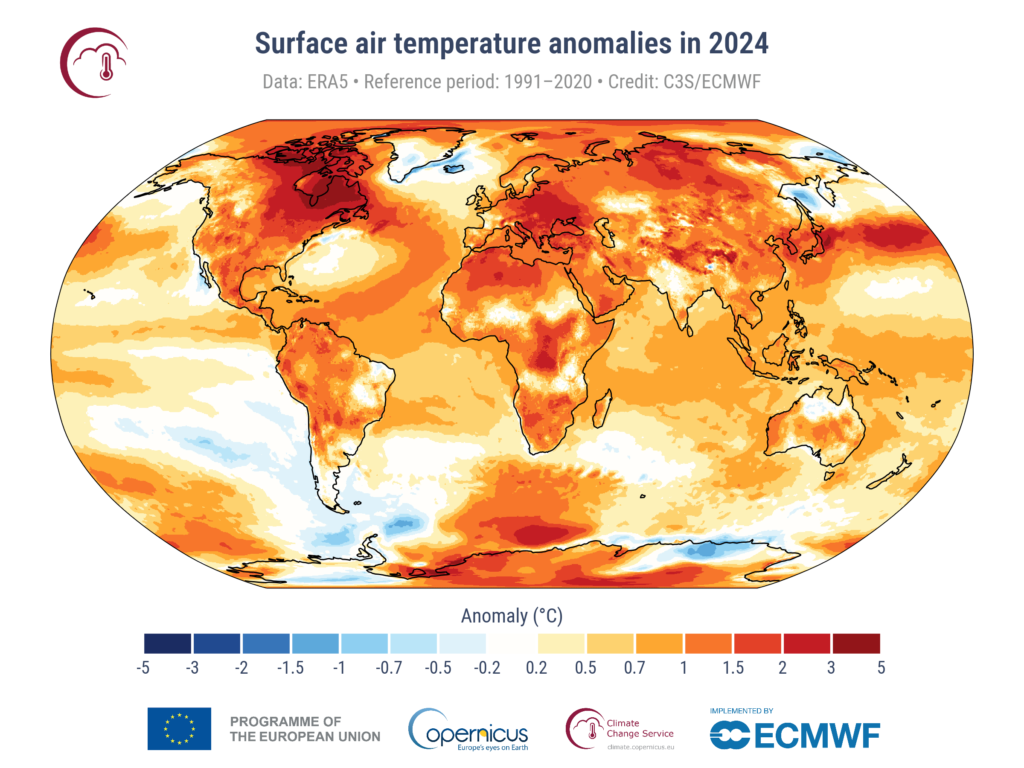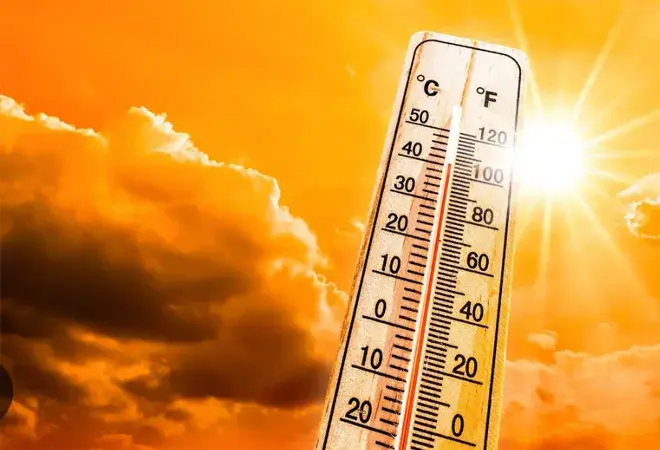In spite of numerous COP’s ( UN conferences on Climate Change) where pledges were made to keep the human-induced global warming below 1.5°C ,pre industrial level, in accordance with Paris agreement-2015 ( COP21), Human-induced climate change remains the primary driver of extreme air and sea surface temperatures. 2024 is confirmed by the Copernicus Climate Change Service (C3S) to be the first calendar year that the average global temperature exceeded 1.5°C above its pre-industrial level.
C3S is implemented on behalf of the European Commission by the European Centre for Medium-Range Weather Forecasts (ECMWF), whose scientists have been monitoring key climate indicators, and documenting unprecedented daily, monthly, and annualtemperature records over 2024. The following organisations involved in global climate monitoring – ECMWF, NASA, NOAA, the UK Met Office, Berkeley Earth and the World

Meteorological Organisation (WMO), have made a concerted effort to coordinate the release of their data, highlighting the exceptional conditions experienced during 2024.
Global surface air temperature highlights:
- 2024 was the warmest year in global temperature records going back to 1850. According to ERA5 (1), the global average temperature of 15.10°C was 0.72°C above the 1991-2020 average, and 0.12°C above 2023, the previous warmest year on record. This is equivalent to 1.60°C above an estimate of the 1850-1900 temperature designated to be the pre-industrial
level. - 2024 is the first calendar year that has reached more than 1.5°C above the pre-industrial level.
- Each of the past 10 years (2015–2024) was one of the 10 warmest years on record.
- The monthly global average temperature exceeded 1.5°C above pre-industrial levels for 11 months of the year. Going back further, all months since July 2023, except for July 2024, have exceeded the 1.5°C level.
- A new record high for daily global average temperature was reached on 22 July 2024, at 17.16°C.
- 2024 was the warmest year for all continental regions, except Antarctica and Australasia (2), as well as for sizeable parts of the ocean, particularly the North Atlantic Ocean, the Indian Ocean, and the western Pacific Ocean.
- 2024 saw three record-warm seasons for the corresponding time of the year: boreal winter (December 2023-February 2024), boreal spring (March-May) and boreal summer (June-August) at 0.78°C, 0.68°C and 0.69°C respectively above the 1991-2020 average.
- Each month from January to June 2024 was warmer than the corresponding month in any previous year on record. Each month from July to December, except August, was each the second warmest, after 2023, for the time of year. August 2024 was tied with August 2023 as the warmest on record.
Carlo Buontempo, Director of the Copernicus Climate Change Service, ECMWF comments: “All of the internationally produced global temperature datasets show that 2024 was the hottest year since records began in 1850. Humanity is in charge of its own destiny but how we respond to the climate challenge should be based on evidence. The future is in our hands – swift and decisive action can still alter the trajectory of our future climate.”
Ocean surface temperature highlights:
- In 2024, the annual average sea surface temperature (SST) over the extra-polar ocean reached a record high of 20.87°C, 0.51°C above the 1991–2020 average.
- The average extra-polar SST was at record high levels for the time of year from January to June 2024, continuing the streak of record months seen in the second half of 2023. From July to December 2024, the SST was the second warmest on record for the time of year, after 2023.
Samantha Burgess, Strategic Lead for Climate, ECMWF comments: “Each year in the last decade is one of the ten warmest on record. We are now teetering on the edge of passing the 1.5ºC level defined in the Paris Agreement and the average of the last two years is already above this level. These high global temperatures, coupled with record global atmospheric water vapour levels in 2024, meant unprecedented heatwaves and heavy rainfall events, causing misery for millions of people.”
Other highlights include:
- The total amount of water vapour in the atmosphere reached a record value in 2024, at about 5% above the 1991–2020 average, according to ERA5, more than 1% higher than in 2016 and 2023, the years with the previous highest and second highest values, respectively.
- Extreme temperatures and high humidity contribute to increased levels of heat stress. Much of the Northern Hemisphere experienced more days than average with at least ‘strong heat stress’ during 2024, and some areas saw more days than average with ‘extreme heat stress’.
- In 2024, the area of the globe affected by at least ‘strong heat stress’ reached a new record annual maximum on 10 July, when around 44% of the globe was affected by ‘strong’ to ‘extreme heat stress’. This is 5% more of the globe compared to the average annual maximum.
- Around Antarctica, after reaching record-low values for the time of year during eight months of 2023, the sea ice extent reached record or near-record low values again during a large part of 2024. From June to October, the monthly extent ranked second lowest, behind 2023 and lowest in November. At its annual minimum in February, the monthly extent ranked third lowest in the satellite record.
- In the Arctic, the sea ice extent was relatively close to its 1991–2020 average until July but fell well below average in the following months. At its annual minimum in September, the monthly extent ranked fifth lowest in the satellite record.
- The atmospheric concentrations of carbon dioxide and methane continued to increase and reached record annual levels in 2024, at 422 parts per million (ppm) and 1897 parts per billion (ppb) respectively. Carbon dioxide concentrations in 2024 were 2.9 ppm higher than in 2023, whereas methane concentrations were 3 ppb higher.
The writer of this article is Dr. Seema Javed, an environmentalist & a communications professional in the field of climate and energy





